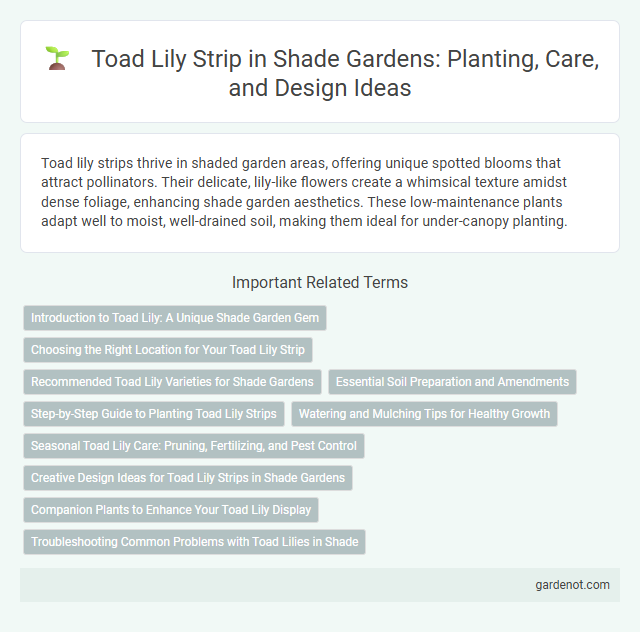Toad lily strips thrive in shaded garden areas, offering unique spotted blooms that attract pollinators. Their delicate, lily-like flowers create a whimsical texture amidst dense foliage, enhancing shade garden aesthetics. These low-maintenance plants adapt well to moist, well-drained soil, making them ideal for under-canopy planting.
Introduction to Toad Lily: A Unique Shade Garden Gem
Toad lily (Tricyrtis spp.) thrives in shaded garden areas, offering exotic, orchid-like flowers that bloom in late summer to fall. This perennial is valued for its speckled petals and ability to brighten dark, moist garden spots, attracting pollinators such as bees and butterflies. Ideal for shade gardens, toad lily adds textural contrast and seasonal interest with minimal maintenance requirements.
Choosing the Right Location for Your Toad Lily Strip
Toad lily strips thrive in shaded areas with rich, well-drained soil that retains moisture without becoming waterlogged. Select a location protected from harsh afternoon sun to prevent leaf scorch and promote vibrant blooms. Incorporating organic mulch helps maintain consistent soil moisture and enhances the delicate flowers of Toad lilies.
Recommended Toad Lily Varieties for Shade Gardens
Recommended toad lily varieties for shade gardens include Tricyrtis hirta 'Miyazaki', known for its spotted purple flowers and tolerance to deep shade, and Tricyrtis formosana 'Samurai', which features large, orchid-like blooms in shades of lavender and white. Another excellent choice is Tricyrtis 'Kumpflii', prized for its star-shaped, pale pink flowers that thrive in moist, shaded environments. These varieties contribute texture and late-season color, enhancing the aesthetic appeal of any shaded garden area.
Essential Soil Preparation and Amendments
Toad lily strips thrive in rich, well-drained soil with a high organic matter content, making essential soil preparation critical for robust growth. Incorporate generous amounts of compost or aged leaf mold to improve moisture retention and nutrient availability while maintaining good aeration. Adjust soil pH to slightly acidic, around 6.0 to 6.5, using elemental sulfur if necessary to optimize nutrient uptake for Toad lilies (Tricyrtis).
Step-by-Step Guide to Planting Toad Lily Strips
Prepare the soil by selecting a well-drained, humus-rich area in partial to full shade, ensuring a pH between 6.0 and 7.0 for optimal toad lily growth. Space the rhizomes 12 to 18 inches apart, planting them 1 to 2 inches deep with the growth buds facing upward, then cover lightly with soil and water thoroughly. Maintain consistent moisture during the growing season and apply a layer of mulch to retain soil moisture and suppress weeds around the toad lily strip.
Watering and Mulching Tips for Healthy Growth
Toad lily strips thrive in consistently moist, well-drained soil, so regular watering is essential to prevent dryness without causing waterlogging. Applying a 2-3 inch layer of organic mulch, such as shredded bark or leaf mold, helps retain soil moisture, regulate temperature, and suppress weeds around these shade-loving perennials. Maintaining this balance supports vigorous growth and vibrant blooms throughout the growing season.
Seasonal Toad Lily Care: Pruning, Fertilizing, and Pest Control
Seasonal toad lily care involves careful pruning in late winter or early spring to remove dead stems and encourage healthy growth. Fertilizing with a balanced, slow-release fertilizer in early spring supports robust flowering and foliage development throughout the growing season. Effective pest control includes monitoring for aphids and slugs, applying organic insecticidal soap or slug bait as needed to maintain plant health in shaded garden environments.
Creative Design Ideas for Toad Lily Strips in Shade Gardens
Toad lily strips create stunning visual interest in shade gardens with their delicate, orchid-like blooms and speckled petals, perfect for adding texture and color to darker garden corners. Incorporating layers of hostas, ferns, and astilbes alongside toad lilies enhances the depth and diversity of the strip while maintaining a cohesive, shade-tolerant design. Strategic placement near pathways or water features maximizes the viewing experience and highlights the unique autumn blooms of toad lilies in low-light environments.
Companion Plants to Enhance Your Toad Lily Display
Toad lily strips thrive alongside hostas, ferns, and astilbes, which provide contrasting foliage and texture in shaded areas. Japanese painted ferns and foamflowers add complementary silver and white accents, enhancing the toad lily's speckled blooms. Incorporating shade-tolerant groundcovers like ajuga or sweet woodruff creates a lush, layered garden bed that highlights the toad lily's unique appearance.
Troubleshooting Common Problems with Toad Lilies in Shade
Toad lilies in shade gardens often face issues such as powdery mildew, leaf spots, and stem rot caused by excess moisture and poor air circulation. Managing these problems requires improving soil drainage, removing infected foliage promptly, and ensuring plants receive adequate spacing to promote airflow. Applying fungicides specifically designed for fungal diseases can also help protect toad lilies from persistent infections.
Toad lily strip Infographic

 gardenot.com
gardenot.com